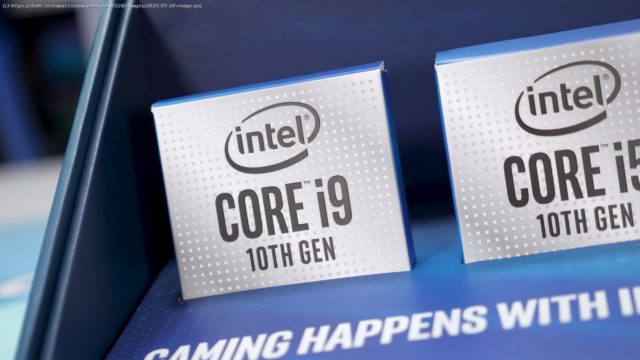Today we’re checking out Intel’s new enthusiast and gaming flagship CPU, the Core i9-10900K. This is a 10-core, 20-thread processor sporting a base frequency of 3.7 GHz and a single core turbo of 5.3 GHz. As the successor of the i9-9900K, Intel’s latest flagship is set to go head to head against AMD’s Ryzen 3900X.
Today we’re checking out Intel’s new enthusiast and gaming flagship CPU, the Core i9-10900K. Not to be confused with the Core i9-10900X which is a pointless 10-core Cascade Lake-X part for the LGA2066 socket, the 10900K is a much more interesting product using the brand new Z490 chipset featuring LGA1200 socket support and a lower price to boot.
The Core i9-10900K is a 10-core,20-thread processor sporting a base frequency of 3.7 GHz and a single core turbo of 5.3 GHz using Intel’s new Thermal Velocity Boost. When compared to its predecessor, the 9900K, the L3 cache size has increased from 16 MB to 20 MB and the TDP has increased from 95w up to 125w. Also like the 9900K, the 10900K has the same $488 MSRP, though there are a few issues with this and we’ll address those towards the end of the review, for now we’re sure you’d rather we got to the benchmarks as quickly as possible.
For testing the Ryzen processors we have used the Gigabyte X570 Aorus Master motherboard, while the 8th and 9th gen Intel Core processors were tested on the Gigabyte Z390 Aorus Ultra, and the new 10th-gen Core processors on the Asus ROG Maximus XII Extreme. All configurations were tested with an RTX 2080 Ti,32GB of DDR4-3200 CL14 memory, and a Corsair Hydro H150i Pro 360mm all-in-one liquid cooler.
We’ve tested the 10900K in two configurations: one is a stock configuration with the XMP profile loaded which sees the multi-core enhancement setting disabled by default, as it should be. The second result which has been labeled “MCE” features multi-core enhancement enabled, this is essentially an overclocked configuration, like enabling PBO on an AMD Ryzen processor, for example.
While testing on the Asus ROG Maximus XII Extreme and MCE enabled, the board maintained an all-core clock frequency of 4.9 GHz, but with MCE disabled the frequency dropped as low as 4.3 GHz. Intel advertises up to a 4.9 GHz all-core turbo depending on workload and duration, so it seems Asus is adhering to that spec.
However, after we had finished all testing we started messing around with other motherboards from other makers and found different boost behavior. Using the MSI Z490 Tomahawk, the board by default runs all cores at 4.9 GHz, regardless of duration, and with MSI’s version of MCE enabled which they call ‘Enhanced Turbo’, the 10900K’s all-core frequency was 5.1 GHz. Basically MSI is allowing the Tomahawk to run in the maximum power state indefinitely, whereas Asus is following the Intel spec and after a short period of time reduces the frequency.
What this means is that the MCE results shown in this review are going to be very similar to what you’ll see out of the box with the Tomahawk and some other motherboards. We simply wanted to point that out as you’re likely going to see some variance in the results from one review to the next, with each board maker interpreting the Intel spec in their own way. We’ve also gone with the Asus motherboard for all our testing as it was provided by Intel for this review. With all that out of the way, let’s get into the results.
First up we have Cinebench R20 and I think the results seen here are going to be quite telling for raw multi-core performance. In its default configuration the 10900K scored 6101 pts and that made it 25% faster than the 3700X and 9900K. Meanwhile enabling MCE boosted performance by a further 5% which is pretty typical for this setting.
When compared to the 3900X, the 10900K was 19% slower, so that means it’s positioned between the 8 and 12-core Ryzen processors and while that’s hardly stocking news, it’s a rough place for Intel new 10-core part to end up given the 3900X can regularly be found on sale for a little over $400, making it cheaper and faster. But before we draw any serious conclusions, let’s move on to check out a lot more data.
The 10900K is very strong in single core performance, thanks to that 5.3 GHz clock frequency. This allowed it to score a very impressive 549 pts making it 3% faster than the 3950X and 6% faster than the 3900X. It’s also an 8% improvement over the 9900K which tops out at 5 GHz.
Moving on to the 7-zip compression test and here we see the 10900K once again finds itself positioned between the 3700X and 3900X, though it’s closer to the 8-core part in terms of performance. Here the 10900K was just 16% faster than the 3700X, making it 17% slower than the 3900X.
The margins are similar when looking at decompression performance as well, here the 10900K was 12% faster than the 3700X but 25% slower than the 3900X. So again not a great place for Intel’s new flagship desktop offering to be at.
The Ryzen processors still largely dominate AES encryption performance and the SiSoft Sandra benchmark is one of the more balanced tests. Despite that though the 3900X was 55% faster than the 10900K.
The 10900K is just 16% faster than the 9900K in the Blender Open Data benchmark and that made it 20% slower than the 3900X. However, enabling MCE does boost performance quite substantially in this test as the all-core clock speed increases from 4.3 GHz to 4.9 GHz, though as you’ll see later in the review this has quite the impact on power consumption.






